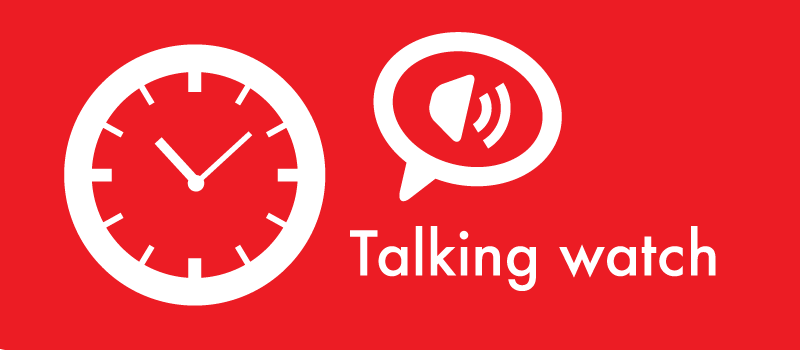Hi my name is John Bailey and I’m the blind guy who sees options.
I’m asked a lot of questions about how blind people (Those with vision impairments) do things. And, one of the most often asked questions is, “How does a blind person tell what time it is?”
Well, if your vision impaired and you can’t easily see the numbers on your watch, there are options. And, what I’m going to talk about is two of those options that are quite affordable and really easy to implement. They make it a lot easier to be independent.
The first kind of device I’m going to talk about that will let you know what time it is without you having to ask anybody is called a ‘talking watch’. It’s pretty much what it sounds like. It’s a regular digital watch with a little extra button on the side. When you press that button, the watch will make an electronic sound. The sound can be like a beep or a chime. Then the watch will announce the time. For example, the watch might say, “1038 A.M.”.
What could be simpler! And, what’s really nice about these kinds of watches is that you can get them very inexpensively. For years, I used several of these plastic talking watches that only cost me about $14.00 each. It worked perfectly for me.
A potential downside to a talking watch is that when you press the button to announce the time, everybody around you can also hear what time it is. That can be embarrassing– especially during meetings. I made that mistake and had to do a lot of explaining.
Let’s say you wanted the independence of telling time for yourself, but you didn’t want everybody around you to know when you pressed the button on your talking watch. Then, you should use a Braille watch. The Braille watch is my timekeeping device of choice now. I use it during presentations when I want to keep track of the time without having everybody in the audience know that I’m checking the time.
There are two differences between a Braille watch and a standard one. The first difference is the front plate (the glass face) lifts up on a hinge thus exposing the hands and numerals underneath. With the glass lifted, it is a simple matter to run a finger over the hands to tell their position and thus know the current time.
If you have seen my Braille watch lately, you may have noticed that it has no glass covering. That is because I wasn’t careful and broke it off. The watch still does what I need so I see no need to get it fixed. A more careful blind person would still have a glass face on there Braille watch.
The second difference between a standard watch and a Braille watch is that not only does the glass part lift up, there are tactile markers put next to some of the numbers to make it easier to get the exact time. The Braille part of a Braille watch comes from the little tactile markers on all the digits.
Now, those are just two ways a vision impaired person who is unable to see the clock or watch can tell accurately what time it is. Independence is very important to the vision impaired. Being able to plan your days and be able to get to appointments on time and manage your medicines independently is really important because you won’t have to depend on others for your health.
Talking watches are easy to use and are inexpensive. However, they are loud and not the choice of timekeeping equipment for those who do presentations and don’t want their talking watches heard by others. If independence and stealth are required, then the Braille watch should be your choice.
Being independent means having the power to make your own decisions. Knowing what your options are enables you to choose for yourself what kind of life you wish to live.
Having options is not just for the vision impaired. Often, people aren’t aware of their options and this can cause frustration. John Bailey is, The Blind Guy Who Sees Options. Feel free to contact me with any questions.


0 Comments